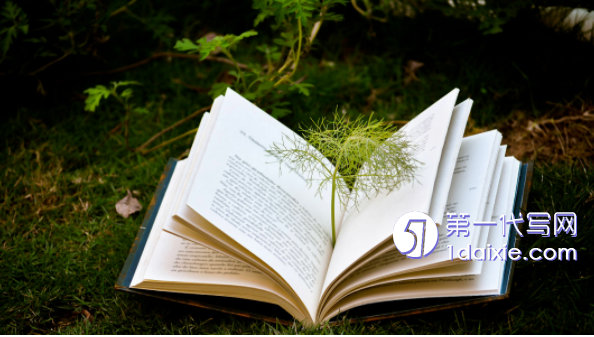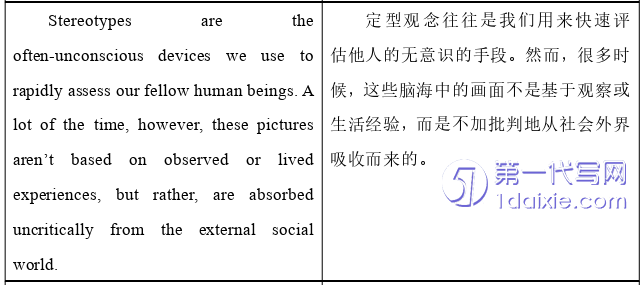本文是一篇英语毕业论文,在交际翻译理论的指导下,译者采取了恰当的翻译技巧来处理不同类别的后置定语。介词短语做后置定语时,译者采用了语序调整和分译;非谓语动词短语作后置定语时,采用了语序调整和转译;
1 Task Description
1.1 Background of the Task
In today’s society,the issues of aging are emphasized by an increasing numberof people.Implicit ageism exists in many aspects of our life and various age beliefshave different impacts on people.The book Breaking the Age Code written by BeccaLevy points out the implicit ageism in our daily life and introduces the differenteffects caused by various age beliefs.As China gradually becomes an aging society,itis a good choice for Chinese readers who are interested in age beliefs to read this book.They will benefit a lot and have a thorough understanding of age beliefs after readingthis book.
Postpositive attributives are widely seen in English and play an important rolein accurately conveying the original meaning of the source text in the E-C translationprocess.Due to the differences in English and Chinese,it is quite challenging for thetranslator to render postpositive attributives that frequently appear in the source text.Therefore,the translator decides to conduct research on how to translate postpositiveattributives in the informative text.More importantly,the translator expects that thisreport can summarize translation techniques in dealing with such difficulties and provide a valuable reference for the translation of postpositive attributives in thefuture.

1.2 Choice of the TextThis translation material is excerpted from the book Breaking the Age Code,which is a typical informative text.There are two main reasons for choosing this textas the translation material.
Firstly,the aging of the population has a profound impact on the developmentof society and the economy.This book explores how different age beliefs affectpeople by listing various examples.Readers will have an objective andcomprehensive understanding of aging and may change their age beliefs after readingthis book.Therefore,it is meaningful to choose this book as the translation material.
Secondly,the translator takes an interest in the field of practical translationwhen taking the course of practical translation in the second semester.The selectedtranslation material belongs to the field of practical translation and there is notranslated version within the current searchable range,which is a big challenge for thetranslator.By translating the chosen material,the translator can not only improvetranslation ability and gain translation experience,but also have a betterunderstanding of the linguistic features of the informative text.
2 Process Description
2.1 Preparation before Translation
It is known that adequate preparation is an important prerequisite for success.The translator should make thorough preparations before translation,includinganalysis of the source text,collection of relevant materials and selection of translationtools.
The first step is to read and analyze the source text.The translator chooses thefirst two chapters from the book Breaking the Age Code with about 10,000 Englishwords for translation practice.This book is an informative text that focuses onfaithfully and smoothly conveying information to readers.“Translation is the processof correctly understanding and creatively reproducing the original text in anotherlanguage”(Zhang,2018,p.9).In order to convey the meaning of the original textprofessionally and objectively to the target readers,the translator should have athorough grasp of the content and internal logic of the selected text.
The second step is to collect relevant materials.The translator collects somerelevant materials about aging such as how aging affects today’s society and thecurrent situation of China’s aging population.By reading related materials,thetranslator learns about different perspectives on aging and deeply understands the source text.What’s more,the translator downloads some relevant books and papers togain more knowledge about translation theories and postpositive attributives,whichare helpful for the following writing.
2.2 Translation Process
After doing the preparatory work such as reading the source text integrally andsearching for relevant materials,the translator starts to translate the source textsentence by sentence under the guidance of Communicative Translation Theory.
It takes the translator fifteen days to complete the first translated version.Sincethe book is mainly about aging and psychology,there are some obstacles such asterms and long sentences with complex structures during translation.“In informativetext,the primary purpose of translation is to ensure the accuracy of information”(Zhu,2004,p.8).Therefore,the translator looks up some dictionaries and papers in CNKIto keep the translation accurate and smooth.During translation,the translator alsofinds that one of the main traits of the source text is the widespread use of postpositiveattributives.In order to convey the information accurately,it is necessary for thetranslator to give further consideration to this phenomenon in the translation process.Then,the translator makes the modification after completing the first translatedversion,and this period lasts for seven days.The translator checks spelling,theaccuracy of terms and the fluency of expressions.The translator also rereads thetranslation to ensure that no words or sentences are left out.What’s more,thetranslator underlines sentences with postpositive attributives and summarizestranslation techniques for further analysis.
3 Case Analysis ........................... 8
3.1 Theoretical Framework ....................................... 8
3.1.1 Introduction to Communicative Translation Theory ................... 8
3.1.2 Reasons for Selecting Communicative Translation Theory ...... 10
4 Conclusion ........................................ 34
4.1 Major Findings ................................... 34
4.2 Limitations ............................................ 36
4.3 Suggestions ......................................... 37
3 Case Analysis
3.1 Theoretical Framework

To accurately and fluently convey the original meaning of the selected text tothe target readers,it is crucial to select a proper translation theory as guidance.Communicative Translation Theory is a significant theory in the field of translation,which was put forward by Peter Newmark.This theory focuses on conveyinginformation according to the culture and expressions of the target language.It alsoputs the target readers first and makes the translation more readable.Taking linguisticfeatures of the source text into consideration,Communicative Translation Theory issuitable to serve as guidance when translating such an informative text.
3.1.1 Introduction to Communicative Translation Theory
Translation plays a crucial role in the interaction between cultures and serves asa communicative activity as well as a language activity.Newmark(2001)proposed Communicative Translation Theory and Semantic Translation Theory in his bookApproaches to Translation and mentioned that“communicative translation attempts toproduce on its readers an effect as close as possible to that obtained on the readers ofthe original”(p.39).Semantic translation is author-centered while communicativetranslation is effect-oriented and reader-centered.In contrast to semantic translation,communicative translation places an emphasis on the understanding and response ofthe target readers and gives the translator more freedom.“The focus ofcommunicative translation is to convey information,which enables readers to think,feel and act.This theory pays attention to readers’understanding and reaction”(Ye,Zhang&Ye,2013,p.99).
4 Conclusion
4.1 Major Findings
The selected translation material is the first two chapters of the informative textBreaking the Age Code.The main purpose of the informative text is to convey facts,information and opinions to the target readers.A large number of postpositiveattributives appear frequently in this typical informative text.These postpositiveattributives convey more information and supplement the meaning of the sentence.Due to linguistic differences between English and Chinese,these postpositiveattributives also lead to some obstacles for the translator in the translation process.Therefore,it is essential to focus on selecting appropriate techniques for translatingpostpositive attributives in the informative text.
Proper translation theory plays an important role in guiding the entiretranslation process.Communicative Translation Theory attaches great importance toexpressing fluently and concisely and tries to make the translation conform to theexpression habits in the target language in order to achieve the purpose ofcommunication.Given the analysis of text and translation difficulties,the translatorreckons that Newmakr’s Communicative Translation Theory is applicable to guide this translation practice.
reference(omitted)
